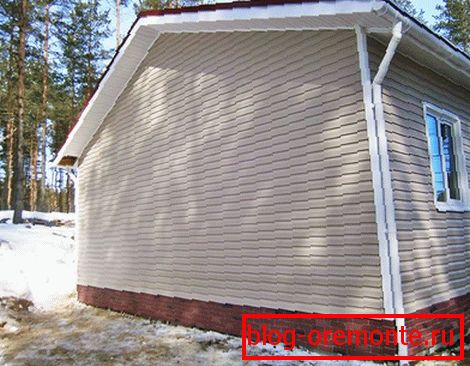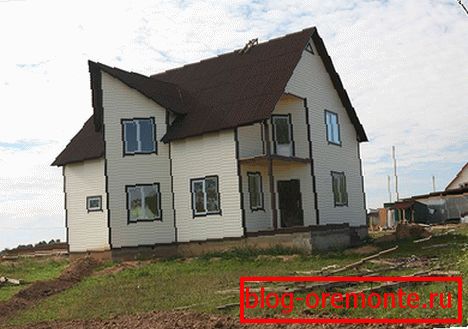Facing the house with plastic panels
The choice of facing material used in exterior decoration of building facades is carried out, as is known, at the stage of preparing the construction project. At the same time, it is necessary to realize that these materials are used not only for decorative purposes. In addition, they protect the structure from the weather and sun exposure, and also protect its walls from the appearance of moisture and mold on them.
In the modern construction market a wide range of facing materials is presented, among which plastic facade panels, well-known to many, are especially popular. This popularity is due to the fact that this material combines a number of advantages that are absent from other finishing coatings. Their advantages include:
- wide range of sizes of plastic blanks,
- wide range of colors,
- quite affordable price.

In addition, the technique of facing the house with plastic panels has a number of indisputable advantages:
- Such coatings are not susceptible to corrosion and are not sensitive to even very large temperature changes.
- when using plastic there is usually no need for special preparation of the working surfaces of the walls. The maximum that may be required of you - is the manufacture of a frame of plastic or metal profiles.
- Facing the facades of the building, consisting in mounting panels on the supporting structures and between themselves, can be done at any time of the year.
Fastening of the panels to the supporting frame (crate) is made, as a rule, with the help of small screws or ordinary self-tapping screws. Note also that their installation can be carried out both horizontally and vertically.
Types of finishing materials and their characteristics

For the manufacture of plastic panels are most commonly used well-known synthetic materials, such as polyvinyl chloride (PVC), metal-plastic or just vinyl. As for their geometrical configuration, the used blanks can have very different sizes, including large four-meter sheets. But most often there are plastic products, made in the form of type-setting panels of a narrow profile or multi-layer sandwich panels.
Due to the wide range of colors, as well as the diversity of the structures obtained during casting, plastic panels can imitate building materials such as metal, brick, wood, as well as marble or artificial stone. Consider some of these imitations.
Facing the facade of the house, made "under the metal", resembles in its structure galvanized steel or aluminum with a smooth (perforated) surface. With a panel thickness of about 0.5 mm, they weigh on average about 0.8 kg / m2. The disadvantage of these coatings is considered to be a low thermal conductivity coefficient and, as a result, poor thermal insulation characteristics.
Vinyl panels are a fairly common type of coatings made from PVC polymers with the obligatory addition of special modifiers. These products are easily fixed on the supporting frame and can be combined in sections of a certain size. Since such a material has a high coefficient of thermal expansion, the grooves for fasteners (nails) are made with a small margin that provides the necessary clearance when fixing sheets. The disadvantages of this type of coatings are to attribute the fragility of the material at low temperatures.

The facing panels stylized under a stone represent a high-quality imitation of natural finishing materials and are often combined with siding coatings already familiar to us.
Mounting technique пластиковых покрытий

Facing panels made of plastic are fixed on the facade in a manner similar to the technique of execution with mounting siding (when installing the latter, the so-called "castle" method is used). In this case, the first (or basement) row of the coating is first mounted, after which the panels of the second row are fixed in the slots of the already installed row.
The technique of cladding buildings with plastic facade panels is best seen on the example of so-called vinyl siding, which is highly resistant to various types of climatic influences. Before starting the main assembly operations, the surfaces of the external walls should be carefully prepared. At the same time, it is necessary to fill in with foam or cover the cracks that are clearly visible to the eye with alabaster, and then remove any irregularities on the wall.

Professional installation of panels involves the use of metal or plastic profiles, on which siding sheets are fixed with special clips.
Note! Since the outer panels are arranged horizontally on the facade of the building, the frame elements for them should be mounted vertically.
Before installing the frame elements using an electric drill, small holes are drilled into them for fastening your chosen look. If self-tapping screws are supposed to be used as fasteners, in order to facilitate the work you should prepare a special tool in advance (a screwdriver, for example).
After the frame for plating with plastic front panels is ready, for the purpose of thermal insulation of the walls of the building, plates of insulation of the chosen type are mounted on it. And only after that you can go directly to the installation of panels, the competent installation of which is possible only if the following requirements are met:
- First of all, it is necessary to accurately calculate the number of sheets required to completely close the surface of the facade. In this case, one should proceed from the standard dimensions of plastic blanks used during installation (their sizes can be in the range from 3 to 30 cm in width and from 2.5 to 4 m in length).
- Panels ready for installation are fixed on metal profiles using ordinary self-tapping screws.
- As for plastic frames, special construction clips can be used to fasten on them. For mounting on wooden crates used small brackets installed using a special stapler.
- Please note that in some types of panels on both sides of the workpiece there are special protrusions (the so-called mounting shelves), which are inserted into the guides of the starting profiles by means of a slight bend and are securely fixed in them.
- For the final installation of the panel in the guide you should knock your fist on its opposite edge slightly. The use of a hammer for this purpose is not recommended.
- At the end of the installation, the wide shelf of the workpiece is fixed on the frame with the help of screws or brackets. It is desirable to use miniature screws 0.5 cm long (sometimes they are also called “bugs” or “flea”).
- After that, you can proceed to the installation of the next panel, carefully watching that the gaps between the mounted workpieces do not exceed the permissible value.
Professional tips

- In the process of mounting a decorative coating, special plastic profiles (so-called moldings) can be used. These auxiliary elements are necessary in order to reliably hide the corner joints of the panels. In addition, they can be used to decorate open joints formed during the installation of blanks.
- To fit the workpiece to the desired size (both in width and height), you can use an electric jigsaw or a manual hacksaw with small teeth.
- In order to avoid thermal deformation when mounting panels between them and the frame elements, it is necessary to leave gaps of at least 3 mm in size.
- Before installation, note that the individual manufacturers on the siding sheets already have holes for fixing them on the supporting frame.
- When working, you should first “wind up” the outer corner and only then proceed to install the current row of panels. All installation operations must be performed with obligatory control of the surface by level and plumb.